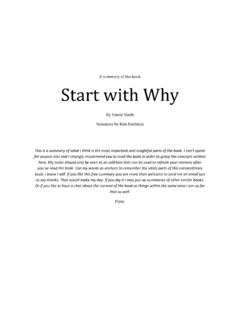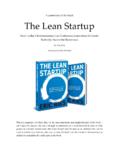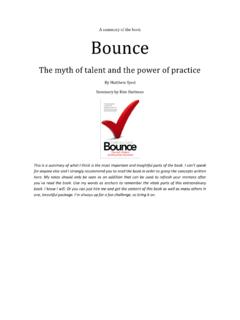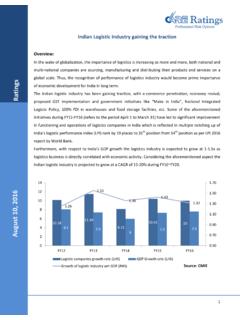Transcription of Traction - Kim Hartman
1 A summary of the book Traction A startup guide to getting more customers By Gabriel Weinberg Summary by Kim Hartman This is a summary of what I think is the most important and insightful parts of the book. I can t speak for anyone else and I strongly recommend you to read the book in order to fully grasp the concepts written here. My notes should only be seen as an addition that can be used to refresh your memory after you ve read the book. Use the words in this summary as anchors to remember the vitals parts of the book. Contents Connect .. 3 Description from amazon .. 4 Chapter 2: The Bullseye Framework .. 5 Step 1: Brainstorm .. 5 Step 2: Rank .. 5 Step 3: Prioritize .. 6 Step 4: Test.
2 6 Step 5: Focusing .. 6 Takeaways .. 6 Chapter 3: Traction Thinking .. 8 3 phases .. 8 Takeaways .. 10 Chapter 4: Traction Testing .. 11 Takeaways .. 11 Chapter 5: Critical Path .. 13 Takeaways .. 14 Chapter 6: Viral Marketing .. 15 Takeaways .. 18 Chapter 7: Public Relations (PR) .. 19 Takeaways .. 20 Chapter 8: Unconventional PR .. 21 Takeaways .. 21 Chapter 9: Search Engine Marketing (SEM) .. 23 Takeaways .. 24 Chapter 10: Social & Display Ads .. 25 Takeaways .. 25 Chapter 11: Offline Ads .. 27 Takeaways .. 27 Chapter 12: Search Engine Optimization (SEO) .. 28 Takeaways .. 29 Chapter 13: Content Marketing .. 30 Takeaways .. 30 Chapter 14: Email Marketing .. 31 1 Takeaways .. 32 Chapter 15: Engineering as Marketing.
3 33 Takeaways .. 33 Chapter 16: Targeting Blogs .. 34 Takeaways .. 34 Chapter 17: Business Development (BD) .. 35 Takeaways .. 36 Chapter 18: Sales .. 37 The SPIN question model .. 37 PNAME .. 37 Sales funnel .. 38 Takeaways .. 38 Chapter 19: Affiliate Programs .. 40 Takeaways .. 40 Chapter 20: Existing Platforms .. 42 Examples .. 42 Takeaways .. 43 Chapter 21: Trade Shows .. 44 Takeaways .. 45 Chapter 22: Offline Events .. 46 Takeaways .. 46 Chapter 23: Speaking Engagements .. 47 Takeaways .. 47 Chapter 24: Community Building .. 48 Takeaways .. 49 More book summaries .. 50 2 Connect 3 Description from amazon Startup advice tends to be a lot of platitudes repackaged with new buzzwords, but Traction is something else entirely.
4 As Gabriel Weinberg and Justin Mares learned from their own experiences, building a successful company is hard. For every startup that grows to the point where it can go public or be profitably acquired, hundreds of others sputter and die. Smart entrepreneurs know that the key to success isn t the originality of your offering, the brilliance of your team, or how much money you raise. It s how consistently you can grow and acquire new customers (or, for a free service, users). That s called Traction , and it makes everything else easier fund-raising, hiring, press, partnerships, acquisitions. Talk is cheap, but Traction is hard evidence that you re on the right path. Traction will teach you the nineteen channels you can use to build a customer base, and how to pick the right ones for your business.
5 It draws on inter-views with more than forty successful founders, including Jimmy Wales (Wikipedia), Alexis Ohanian (reddit), Paul English (Kayak), and Dharmesh Shah (HubSpot). You ll learn, for example, how to: Find and use offline ads and other channels your competitors probably aren t using Get targeted media coverage that will help you reach more customers Boost the effectiveness of your email marketing campaigns by automating staggered sets of prompts and updates Improve your search engine rankings and advertising through online tools and research Weinberg and Mares know that there s no one-size-fits-all solution; every startup faces unique challenges and will benefit from a blend of these nineteen Traction channels.
6 They offer a three-step framework (called Bullseye) to figure out which ones will work best for your business. But no matter how you apply them, the lessons and examples in Traction will help you create and sustain the growth your business desperately needs. 4 Chapter 2: The Bullseye Framework (And no, I haven t forgot chapter 1. I just didn t think it was very interesting.) Bullseye: A simple framework called Bullseye that will help you find the channel that will get you Traction . You re aiming for the Bullseye the one Traction channel that will unlock your next growth stage. Using Bullseye to find your channel is a five-step process: 1. Brainstorm 2. Rank 3. Prioritize 4. Test 5. Focus on what works The optimal channel: It is very likely that one channel is optimal.
7 Most businesses actually get zero distribution channels to work. Poor distribution not product is the number one cause of failure. If you can get even a single distribution channel to work, you have great business. If you try for several but don t nail one, you re finished. So it s worth thinking really hard about finding the single best distribution channel. Step 1: Brainstorm The goal in brainstorming is to come up with reasonable ways you might use each Traction channel. If you were to advertise offline, where would be the best place to do it? If you were to give a speech, who would be the ideal audience? It is important that you not dismiss any Traction channel in this step. You should be able to think of at least one idea for every channel.
8 It s especially important to understand how similar companies acquired customers over time, and how unsuccessful companies wasted their marketing dollars. Step 2: Rank The ranking step helps you organize your brainstorming efforts. It also helps you start to think a bit more critically about the Traction channels in aggregate. Place each of the Traction channels into one of three columns, with each column representing a concentric circle in the Bullseye: Column A (Inner Circle): which Traction channels seem most promising right now? Column B (Potential): which Traction channels seem like they could possibly work? Column C (Long-shot): which Traction channels seem like long-shots? 5 Step 3: Prioritize Now identify your inner circle: the three Traction channels that seem most promising.
9 If you already have three channels in Column A, you re done! If you have more than three, then you need to get rid of some and vice-versa. Step 4: Test The testing step is where you put your ideas into the real world. The goal of this step is to find out which of the Traction channels in your inner circle is worth focusing on. You will make that decision based on results from a series of relatively cheap tests. These tests should be designed to answer the following questions. Roughly how much will it cost to acquire customers through this channel? How many customers do you think are available through this channel? Are the customers that you are getting through this channel the ones that you want right now?" When testing, you are not trying to get a lot of Traction with a channel just yet.
10 Instead, you are simply trying to determine if it s a channel that could work for your startup. Your main consideration at this point is speed to get data and prove out your assumptions. Step 5: Focusing If all goes well, one of the Traction channels you tested in your inner circle produced promising results. In that case, you should start directing your Traction efforts and resources towards that most promising channel. At any stage in a startup s lifecycle, one Traction channel dominates in terms of customer acquisition" Repeating the Process: If, unfortunately, no channel seems promising after testing, the whole process should be repeated. Takeaways The Bullseye Framework is a five-step repeatable process to maximize your chances of getting Traction : brainstorm, rank, prioritize, test, and focus.










